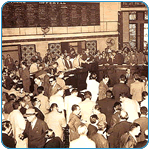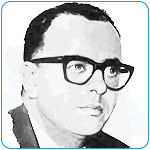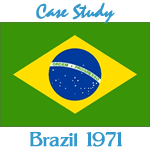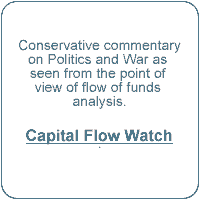 Brazil: Economic Miracle and Capital Market Reform
Brazil: Economic Miracle and Capital Market Reform
Case Study: The Brazilian Stock Market
Brazil: The Economic Miracle and Capital Market Reform
Capital Market Reforms of 1964-1970
One of the priorities of the revolutionary government in 1964 was to build a domestic capital market.
There were two reasons for this, political and economic.
- The political reason was to to install 'democratic capitalism' that was expected to serve as a vaccine against communism. The goal was to have as many Brazilians as possible owning shares of Brazilian companies.
- The economic reason was to provide long-term capital so that local businesses could participate in planned rapid economic growth. Without a domestic capital market, development would be too dependent on foreign capital with negative political implications.
Foreign capital and loans were rationed under a system that discouraged foreign portfolio investment in Brazilian equities in favor of organized direct investment in basic industry.
 Foreign portfolio investment was not important in the early development of the Brazilian capital market
Foreign portfolio investment was not important in the early development of the Brazilian capital marketBecause of barriers to foreign portfolio investment, the Brazilian equity market was almost entirely domestic, although a few foreign expatriates played important roles.
In the 1960s, it was not widely understood that a capital market could be created from scratch in developing countries in a relatively few years. Many in the United States (including 'Engine Charlie' Wilson of General Motors) said that if businesses in developing countries needed capital they should come to New York. Some sociologists even thought that capital markets could develop only in countries that met certain legal, religious, ethnic, and even climatic conditions.
Nevertheless, Brazilians were willing to use imagination and commonsense in developing their own capital market. In this they were successful.
The country was fortunate to have three pragmatic finance ministers presiding over the fifteen years of the Economic Miracle: Oct�vio Gouv�ia de Bulh�es, Ant�nio Delfim Netto, and M�rio Henrique Simonsen.
In early 1960s, many ideas for capital market modernization and support for implementation came from individuals in the private sector, mostly in their twenties and early thirties, usually based in Rio de Janeiro and working informally on an ad hoc basis with government economists.
 D�nio Nogueira, the first president of Brazil's Central Bank, played a key role in reforming the capital market
D�nio Nogueira, the first president of Brazil's Central Bank, played a key role in reforming the capital marketThis group included, among others, Pedro Leit�o da Cunha, Ary Waddington, Geoffrey Ainsworth Langlands, J�lio C�sar Belis�rio Viana, John Oswin Schroy, Jorge Paulo Lemann, and Roberto Teixeira da Costa.
The government of Castelo Branco, 1964-1967, was a time of extraordinary innovation and progressive reform of the capital market:
- The hereditary oligarchy of official stock brokers was diluted when new members were admitted to privatized stock exchanges;
- New financial institutions were authorized and licensed. Capital was invested in stock brokers, investment banks, mutual funds, finance companies, securities distributors, and mortgage banks.
- The National Economic Development Bank (BNDE), working with New York University, sponsored scholarships and training loans for Brazilian capital market professionals.
- The government bond market, long dormant and discredited, was brilliantly revived with the Readjustable Obligations of the National Treasury, becoming Latin America's largest government bond market within six months. An over-night funds market developed to support bond traders.
- The first securities broker-dealer meeting international standards for internal controls and customer security was organized (S-N Investimentos S.A.).
- Conta Garantia, the world's first money market fund was organized in 1968, two years before a money market fund was formed in the U.S..
- Brazilian stock issuers went to great lengths to woo domestic shareholders, offering, in addition to guaranteed dividends and 'stock bonuses', shareholder discounts on goods and services, factory tours, and 'shareholder departments' with coffee and cookies. The use of participating preferred shares was essential in providing incentives to family-owned companies and protection to investors.
- The Brazilian government offered advantages to issuers dependent upon the number of public shareholders. These advantages included lower taxes, priority in licensing, and favored treatment at financing agencies.
- Investors were allowed to divert 10% of their income tax for investment in '157 funds' (named after Decree-Law 157 of 1967) to be held in blocked accounts for seven years and invested in public companies by professional investment managers.
- The Minister of Finance, Oct�vio Gouv�ia de Bulh�es, ordered the Rio de Janeiro Stock Exchange to undertake a modernization study. This study, prepared by Servi�o Nacional de Investimentos Ltda., called for pre-trade verification of customer credit, electronic matching of orders, same-day book-entry DVP settlement in a central depository, an open-order-book communications network, and improvements in securities trading rules. (Although not implemented, this study opened minds to improvement in exchange operations.)
With regards to capital market development, leadership was provided by a group of carioca economists associated with the Funda��o Get�lio Vargas and SUMOC, including Oct�vio Gouv�ia de Bulh�es, Jos� Garrido Torres, D�nio Nogueira, and M�rio Henrique Simonsen.
By 1970 Brazil had become the largest securities market in Latin America, a position that it retains to this day, although the location of the principal exchange has shifted from Rio de Janeiro to S�o Paulo.
Despite the rapid increase in prices since the 1950s, stocks of solid companies still traded in 1970 at five to ten times earnings, while paying attractive dividends.

